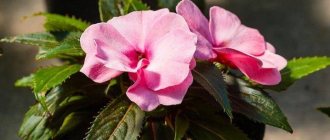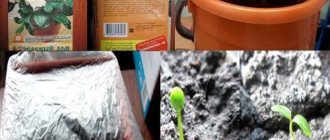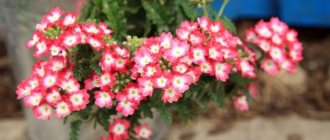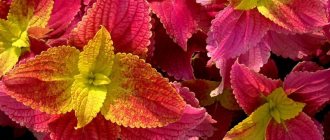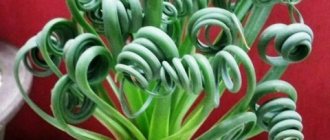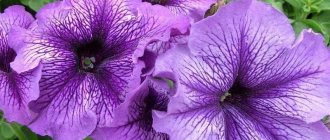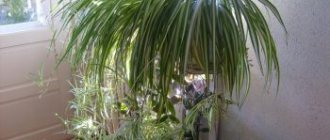Features of balsams
Indoor balsam
The flower belongs to the genus Balsaminaceae and is part of a larger family of the same name. Its name, translated from ancient Latin, means “sensitive, not liking pressure.” Because of its delicate stems, balsam is called impatiens. And the property of ripe fruits to scatter seeds at the slightest touch gave the flower another apt name “jumper”. But that is not all. “Vanka is wet” - due to moisture on the leaves, which can release it after watering. “Vanka-Vstanka” - for the ability to grow upward, no matter how the pot stands. “Spark” - for the flaming shade of the petals. “Beautiful Wreath” is an Austrian name. In England, the constantly flowering plant is called "Business Lizzie", in Germany - "Eager Lizzie".
Africa is considered the birthplace of balsams. The flower also grows in Central Asia. In the temperate climate of European countries, the exotic beauty began to be grown several centuries ago. The Portuguese brought this cozy plant with lush flowers.
Impatiens can be grown as annuals or perennials. In autumn, after flowering in open ground, they are removed. Flowers have a delicate root system that does not tolerate winter cold. Only part of the seeds that fall into the ground by self-sowing can easily withstand frost and sprout next spring. Perennial flowers are grown at home. If all requirements are correctly met (and they are quite simple), impatiens bloom all year round.
Terry balsam
Externally, all varieties of balsams are similar. These are herbaceous plants with fragile succulent stems. According to their growth form, they can be bushy, erect or hanging . The height ranges from 20 cm (Tom Tamb balsam) to 1 m (Balfour's balsam). The leaves of the plant are oval-heart-shaped, their color varies depending on the variety: from green to burgundy or variegated. Balsams are bred for their lush flowering. The flowers are single or collected in inflorescences, the shades come in a variety of colors. Among the popular varieties are balsams with double buds. Later, fruit boxes form in place of the flowers.
Today, over 500 types of balsams are known, a large number of varieties and hybrids, allowing you to choose the right plant based on height, bush shape, leaf and flower color, and bud size.
New Guinea balsam
Among the most popular varieties, Waller's balsam stands out, perfect for both garden and home cultivation. The latest “acquisition” of gardeners is New Guinea balsam, a beautiful, unpretentious and hardy plant.
When to transplant balsam seedlings into open ground
Before planting balsam in a flowerbed, the seedlings should be hardened off. Pots with plants are taken out to the balcony or outside for several hours during the day. The residence time is gradually increased.
The approximate date for transplanting into open ground is the 20th of May. But here you should pay attention to the weather conditions of the regions. The main thing is that the threat of spring frosts has passed. If the air temperature remains quite cool, then it is recommended to cover the flower beds with covering material.
Adaptation of seedlings will be successful if you follow the recommendations of experienced gardeners:
- balsam loves the sun, but in the heat the tender leaves can get burned; therefore, choose an area with light partial shade;
- but a lack of lighting will cause the bush to stretch excessively and produce small flowers;
- holes for planting are prepared in advance by placing complex fertilizer on the bottom;
- the gap between the bushes is maintained within 20-60 cm (depending on the selected type);
- before removing the seedlings from the container, water the soil mixture;
- the seedlings are removed along with the earthen lump; if the soil has crumbled, then carefully straighten the roots, lightly pinch them and lower them into the hole;
- deepen the plants to the level of the cotyledons, sprinkling the free space with substrate.
The soil around the balsam is crushed, watered and mulched. All other actions come down to regular care of the flower garden.
Growing conditions
Planted cuttings of a hybrid variety of balsam
Impatiens propagate in two ways: cuttings and seeds . The first method is simpler and allows you to grow an individual with maternal properties. The second option is more complex and interesting, and by crossing two plants you can get a flower with original characteristics.
For experienced gardeners, growing balsams is not difficult. Those who are just starting to grow house plants need to familiarize themselves with the conditions for their cultivation and the necessary rules of care. And here are complete instructions for growing balsams from seeds.
Seed selection
Balsam seeds
To ensure that the work of growing balsam from seeds at home is not in vain, you need to take a responsible approach to the choice of seed material.
Points to pay attention to:
- Best before date . Balsam seeds have a long germination period - 7–8 years. All information about a specific planting material can be read on the bag. The collection date is also indicated there, which will give an idea of the freshness of the seeds.
- Annual or perennial . Impatiens are perennial plants. But in open ground they are grown as annuals, because the plant's delicate roots do not tolerate cold. In the fall, before frost, the plants are removed. To admire the flower for more than one year, it is grown at home.
- Mixture or variety . If the word “mixture” is indicated on the bag, then it is not yet known what color of flowers you will get. Therefore, if you want to grow a specific balsam with the desired properties, you purchase a specific variety.
- Hybrids . Many of these plants bloom well at home and easily tolerate indoor seasonal dryness. But they practically do not form seeds. Therefore, such varieties are propagated by cuttings. It will not be possible to repeat a hybrid variety using seeds.
Purchased balsam seeds
Experienced gardeners know that they need to buy seeds in trusted specialized stores; preference is given to products from a reliable manufacturer. It is not recommended to purchase balsam sachets on sales or in large retail chains . The probability of getting absolutely the wrong plant is too high. And the germination of such seeds is a big question.
Checking seed germination
Some sources also indicate this method of testing seeds for germination: they should be placed in a bowl of room water. They say that good seeds will sink to the bottom, bad ones or “dummies” will float to the surface. But this test is used mainly on freshly harvested seeds. Purchased planting material will not show accurate results.
Landing dates
Homemade balsam blooms all year round. And the timing of planting young plants usually does not matter. But if you want to show off young flowering bushes at some point, then you need to plant the seeds 3-4 months before the appointed time. On warm summer days, you can decorate your balcony or loggia with flowers. Then the crops are sown in February - March.
Disinfection of seeds in potassium permanganate
But even before planting, the seed should be disinfected. This will provide an additional guarantee that accidentally infected seeds will not spread the disease to all seedlings. For disinfection, prepare a weakly saturated solution of potassium permanganate and dip a gauze bag with seeds into it for 20 minutes. Next, everything is washed under running water and left to dry for a short time if planting is planned for another day.
Soil requirement
Ready-made soil mixture
Young seedlings, which are more sensitive to the environment, require specific soil. When growing balsam from seeds, you need light, slightly acidic, moderately nutritious soil. Too fertilized soil will lead to deficient balsam flowering. They will grow stems and leaves, but have difficulty opening buds.
The easiest way is to buy soil in a specialized store. Impatiens are not too picky; ordinary soil for flowering indoor plants is also suitable.
Experienced gardeners make up their own soil mixture. For example, one of her recipes might include the following ingredients:
- turf soil - 2 parts;
- soil with foliage - 2 parts;
- humus - 2 parts;
- sand - 2 parts;
- peat - 1 part.
Some make it simpler: they make up a substrate of peat and vermiculite (perlite) in a 1:1 ratio. The second component of the soil helps regulate moisture and protects the plant roots from rot.
Disinfection of soil in the oven
The prepared soil is calcined in the oven to destroy harmful microorganisms. It would also be useful to treat the soil with fungicides - chemical or biological preparations that prevent flowers from becoming infected with fungal diseases.
How to grow statice: step-by-step instructions
To sow statice and grow this beautiful flower, you need to carefully and correctly organize the process of sowing seeds. This takes some time, since all activities are divided into several stages.
Seed preparation
Kermek seeds have a very dense shell, through which it is quite difficult for sprouts to break through. Therefore, before sowing, it is necessary to grind the grains, but this should be done very carefully, using soft sandpaper. After this, it is recommended to further soak the seeds in Epin solution for 5-6 hours. If this is not possible, they can be placed in damp sawdust for several days.
Selection of capacity
Statice can be grown in boxes, containers or cassettes of any shape and size. If you plan to grow a flower as an indoor ornamental plant, plastic cups or flower pots are used for this purpose.
The soil
In a specialized store you can purchase ready-made soil for growing Schisandra Tatarian. It’s also possible to make it yourself. To do this, take river sand and leaf soil in equal proportions and mix well. Before packaging the substrate into containers, it is recommended to heat it a little in the oven and then generously moisten it with water.
Sowing seeds and care
When all stages of preparation have been completed, you can proceed to sowing Kermek. Basic steps:
- Place the seeds and take out the containers. Sprinkle the calcined soil with potassium permanganate for disinfection purposes.
- Moisten the soil and place the seeds at an equal distance from each other. Lightly sprinkle soil on top.
- Cover the crops with film or place glass on top of the container. Do not remove until the first shoots appear, which will appear in about 21 days.
- The seedlings must be ventilated regularly. We must not forget about carefully loosening the soil.
- Watering the seedlings is carried out by irrigating the soil. This should be done using a sprayer, avoiding liquid getting on the leaves.
- When stems with 2-3 strong leaves appear in the container, the seedlings can be planted in separate cups.
Seedlings must be hardened before diving to a permanent place of growth. To do this, the containers should be taken outside, gradually increasing the time they stay there. After this, the seedlings can be planted into the ground.
It is allowed to sow statice seeds directly into open ground. This process is not much different from sowing seedlings, except for the timing of planting and the need to use additional means to place the seeds at an equal distance from each other.
Sowing seeds
Preparing pots for planting seeds
Containers for seedlings are prepared in advance. These can be boxes, containers or pots slightly more than 7 cm high. Drainage holes are a prerequisite. A layer of expanded clay (1/5 of the height of the pot) is placed on the bottom of the prepared container, and the prepared soil is poured on top. It is advisable to spill the soil with a solution of “Fitosporin”, which enhances the protective properties of plants, prevents various diseases and improves the soil microflora.
Planting balsam seeds
Next, proceed to planting:
- The prepared soil in the container is watered with water.
- Seeds are distributed over the surface of the soil. This can be done with a thin stick or a regular toothpick. Wet the tip of the toothpick with water, pick up the seed and press it to the ground, slightly deepening it.
- Spray the surface of the soil with seeds from a spray bottle.
- Cover the container with a transparent lid or simply pack it in a plastic bag.
- The container with the seeds is placed on the windowsill. It is better to choose those windows where direct rays of the sun do not fall. The room temperature should be between 22–25 °C.
- Seedlings must be ventilated. To do this, remove the covers or cellophane, wipe off the condensation from them and let the soil breathe a little.
The first shoots appear after 18–20 days.
Growing seedlings
Balsam shoots
For growing balsam from seeds, the optimal temperature is 23–25 °C. The containers are placed on a bright windowsill, but not in direct sunlight. After the first shoots appear, the bags and lids are removed from the containers, and the soil is moistened with a spray bottle. As the seedlings grow, you can carefully add soil, covering the young bare roots. Watering young plants should be uniform and sufficient, but do not over-water or dry out the soil.
Transplanted balsam sprouts
The first true leaves have appeared, which means it’s time to pick. Seedlings are planted in separate containers, for example, plastic cups. If the sprouts have stretched out a little, when replanting, they are buried a little more. Sufficient watering and lighting are important conditions for the correct and even development of small impatiens. They become strong and begin to grow side stems. If there is no branching, the tops of the bushes are pinched. This gives impetus to the active formation of side shoots. Their number directly affects the splendor of the future bush and the abundance of flowering.
Transplanting balsams into pots
The young seedlings grew up, and their roots entwined the earthen ball, filling the entire small container. The time has come to transplant the plant to a permanent place of residence in pots or flowerpots. Impatiens require a compact container so that after filling the space of the pot with roots, the flower will produce buds. When planted in pots that are too large, all the strength of the plant will go into growing greenery. It may not even come to flowers.
Home care
When growing balsam, special conditions and careful care are not required. The plant will be comfortable in any bright place in the room. “Sparks” do not like direct sunlight and dark corners. And the favorite habitat is considered to be window sills facing the east or southeast side. In a bright room, balsams can be placed between two windows, then the buds will be even brighter than on the open areas of the window sill. In the summer, flowers are taken out for a walk and placed in the fresh air. Balconies, terraces, gazebos, but sheltered from wind and rain, are suitable for this.
Impatiens respond gratefully to watering. Succulent stems require a lot of water, and in the absence of moisture, the plants begin to turn yellow and drop flowers. In summer, the flower is watered abundantly almost every day, preventing the earthen clod from drying out. Water is poured so much that it begins to appear in the pan, from where it is then removed. Good drainage during such water procedures will prevent the roots from rotting. In winter, watering is reduced to two to three times a week, but it is also undesirable to allow the soil to dry out. The plants need to be sprayed periodically, avoiding water getting on the open buds.
Phosphorus-potassium fertilizer
To fertilize balsams, complex fertilizer is used. The first time nutrients are added immediately after transplanting young plants into permanent pots. From spring to autumn during the growing season, the flower is fed twice a month. But don’t be too zealous with nitrogen fertilizers. A large number of them can lead to growth of stems and delayed flowering. The best choice during this period will be phosphorus-potassium fertilizers. In the period from autumn to spring, the amount of fertilizing is reduced to 1 time per month.
To stimulate the growth of new shoots and more luxuriant flowering, the balsam bush is pruned annually. They do this in the spring. The removed parts can be used for propagation by cuttings.
Application in landscape design
Some varieties of garden balsam can be successfully used as a ground cover crop.
Small bushes look great in the design of an alpine hill or for framing an artificial pond.
You can decorate your terrace or gazebo with hanging pots of impatiens; Balsam is also suitable for decorating a window sill in a Mediterranean style.
Garden balsam is a great solution for the busy gardener. This undemanding plant only needs regular watering and fertilizing, but its flowering will last almost the entire summer.
How to collect seeds?
"Seed pod" of balsam
In the wild, balsams reproduce by self-sowing. Ripe seed pods crack and scatter seeds around them. At home, it is better to take control of this process, otherwise there is a risk of losing some of the seeds or getting a lot of “cuckoo babies” in other flower pots.
But first, the flowering balsam still needs to be pollinated. Use a soft brush to collect pollen and apply it to the pistils. In place of the flowers, green berries are formed, which later turn into white boxes. It's time to collect the seeds. To prevent them from spilling out onto the ground, carefully take the box with two fingers and shake it over a placed plate. Some people suggest tying the fruits with a piece of cloth so that the seeds do not get lost when opening the boxes. The collected material is dried in a ventilated place at a temperature of about 30 °C and stored in paper bags.
When to plant balsam seedlings
Most often, balsam is grown through seedlings, since this technique allows for early flowering in flower beds. The timing of sowing is directly related to the growing region and depends on climatic conditions. In addition, planting depends on the weather forecast for the current season.
The timing of planting garden balsam is determined based on the region:
- in the central regions this period falls on March-early April;
- for areas to the south, you can start sowing in February-March, but with the obligatory additional illumination of seedlings;
- in the northern regions it is advisable to grow balsam in greenhouses; therefore, it is better to sow seeds in mid-spring;
- for hanging species, the optimal time is at the turn of March-April.
If balsam is grown as a houseplant, then you can do without seedlings by planting seeds in flower pots in any month.
Many gardeners use hints from the Lunar calendar. It is believed that depending on the phase of the moon, certain parts of the plant (aerial or roots) grow intensively. There are favorable dates for sowing various crops and days prohibited for agricultural work. For example, on the days of the Full Moon and New Moon you cannot plant or prune plants.
When to sow balsam seeds for seedlings in 2022, in what month:
- in February : 3, 8, 12, 13, 14, from 17 to 23;
- in March : from 11 to 13, 16, 17, from 19 to 24, from 29 to 31;
- in April: 3, 4, 8, 9, from 13 to 15, 17, 18, 26, 27.
Transplanting an adult plant
Take a small pot for the plant. You can plant several seedlings at once in a larger container. And if you take balsams with flowers of different shades, then such a composition will look incredibly beautiful.
When growing balsam, an adult flower is replanted once a year in the spring. Some gardeners do this twice: in spring and autumn. Transplanted and rejuvenated, it will produce more shoots and bloom more luxuriantly. This procedure is required for store-bought balsam. A day before the proposed transplant, water the plant thoroughly, thoroughly wetting the earthen ball. Having taken the flower out of the old pot, inspect the root system. Dry and damaged roots are cut off with a knife, and the cut areas are sprinkled with activated carbon. The plant is placed in a new pot without deepening the root collar.
Diseases and pests of balsam
Powdery mildew on balsam
When growing balsam from seeds at home, improper care can lead to plant diseases. Another danger for a weakened green pet is the invasion of insect pests. Rescue of plants should begin at the first signs of disease and the appearance of uninvited guests.
Impatiens prefer frequent watering and humidified air. In such almost ideal conditions, the following diseases can develop:
- Downy mildew . In a hot, dry room, when water stagnates in pots, a white coating appears on the leaves. Later the leaf blades turn black and fall off. Fungicides are used for treatment.
- Bacteriosis . The disease can result from overwatering at low temperatures. Black spots appear on the leaves. The affected areas are removed, and the plant is treated with Bordeaux mixture.
- Root rot . The cause is stagnation of moisture in the soil. At the onset of the disease, the damaged parts of the root are removed, and the flower is transplanted into new soil with drainage.
The main insect pests that threaten balsams are whiteflies and spider mites. They appear on plants weakened as a result of improper care and maintenance. Plants are saved by rinsing in a soapy solution and spraying with infusions of garlic and herbs. In advanced conditions, chemicals are used.
The most popular indoor varieties of balsams
Several decorative types of balsam are often grown at home:
Waller's balsam (Willer ). Perennial with regular or double flowers of various colors. Stems are oblong. Above the green mass there are many bright buds.
Peters' balsam . It differs from the first one in its larger size and bronze color of the stems and leaves. The flowers are a rich red hue; lilac and pink varieties are less common.
New Guinea balsam . It has a stronger stem, fleshy leaves and large flowers (5–8 cm). The bush itself is very compact, which is appreciated in home floriculture. The hybrid is hardy, blooms continuously and has different petal colors.
Balsam tom tumb . A strongly branched dwarf plant up to 25 cm high. The flowers are bright and double. In open ground it blooms from June until frost. Perfect for home growing.
Impatiens is the very case when you can grow a beautiful plant without special knowledge of gardening. A little attention, care and love, and the green pet will thank the owner with bright, lush and long-lasting flowering.
Differences in the propagation of garden and indoor flowers
Annual balsams are suitable for planting in open ground in the summer; perennials should be chosen for growing at home.
Garden balsam can be sown directly into the ground immediately after frost, but be sure to cover the sowing area with film or glass.

